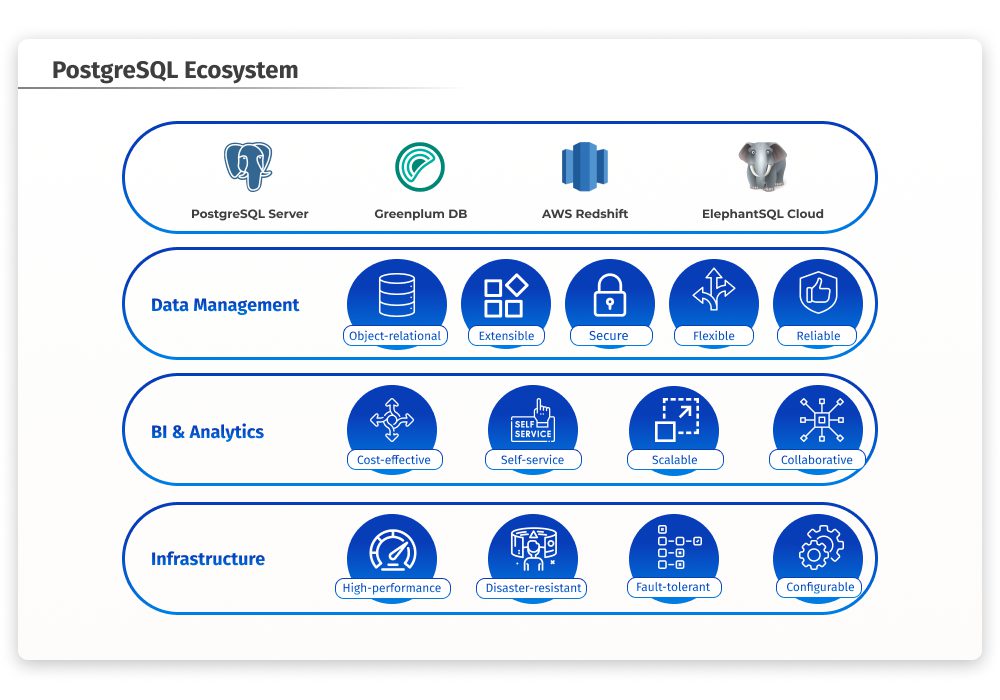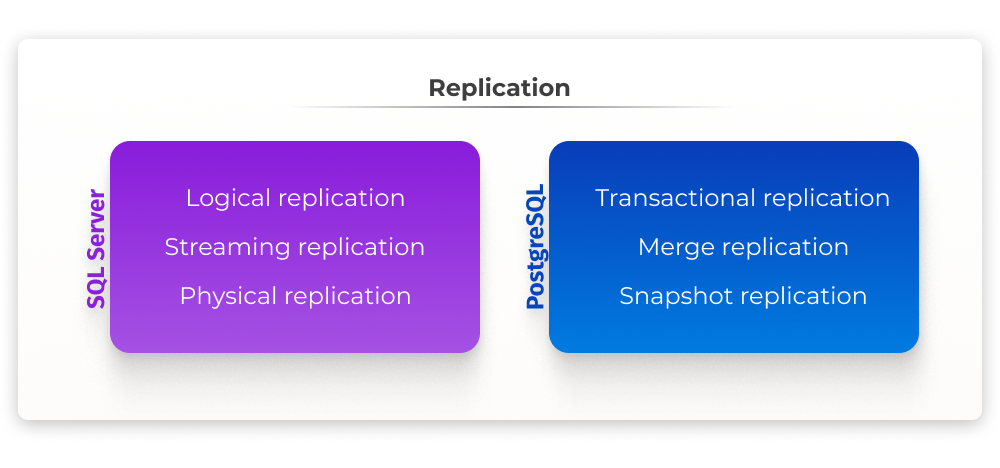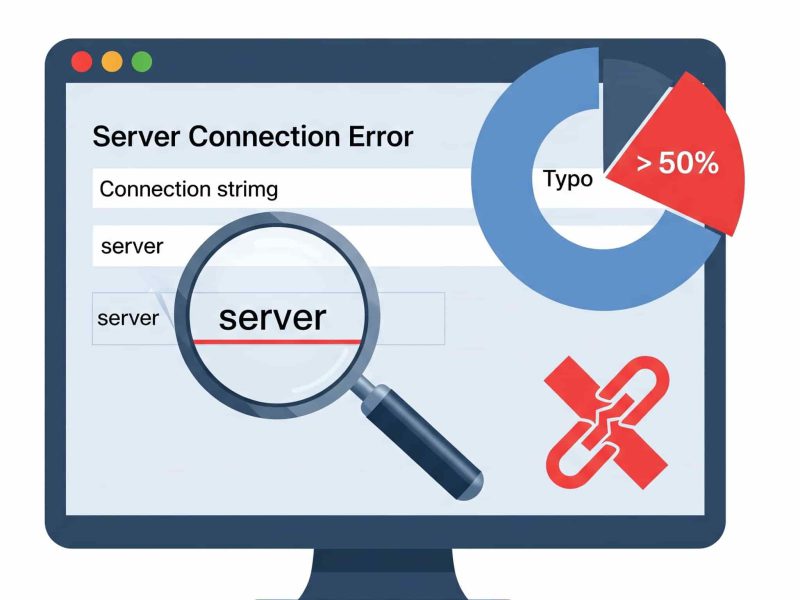In the current business environment, efficient data management and storage are more important than ever. Because of this, choosing the best database management system for a given project can be challenging. Since there isn’t a single solution that works for every problem, many organizations must implement several database systems that are suited for various projects. It is crucial to comprehend each system’s capabilities and limitations as a result.
This article compares Microsoft SQL Server and PostgreSQL, two well-known database management systems. We will examine their similarities, differences, applications, and individual benefits and drawbacks.
What is SQL Server?
One of the most potent relational database management systems (RDBMS) used in business IT settings is Microsoft SQL Server. It positions itself as a top-tier database system alongside Oracle Database by providing strong and dependable support for analytics, business intelligence, and transaction processing applications.
SQL Server’s inception can be traced back to the 1980s, when Sybase Inc. started creating software for minicomputers and UNIX systems. The first version of Microsoft SQL Server was released in 1989 as a result of a collaboration between Ashton-Tate Corporation, Sybase, and Microsoft. Microsoft had taken complete control of SQL Server by 1994.
High availability, effective management of heavy workloads, and smooth application integration are the main reasons why SQL Server is preferred. While departmental and workgroup applications were the main focus of early SQL Server versions, later versions brought substantial improvements and functionality to support new technologies like the web, cloud computing, and mobile devices. Currently, SQL Server is an enterprise-class RDBMS that successfully faces off against other premium database systems.
SQL is a standardized programming language used for database management and data retrieval, and it is the foundation of SQL Server. Microsoft’s version of SQL is called Transact-SQL (T-SQL), and it comes with a number of proprietary programming extensions that improve the language’s functionality.

What is PostgreSQL?
A global team of volunteers created the flexible open-source database management system (DBMS) known as PostgreSQL. Its source code is publicly available and operates independently of corporate control.
Michael Stonebraker, a computer science professor at the University of California, Berkeley, initiated the PostgreSQL project in 1986 as a replacement for the Ingres database. It was first known as Postgres, and its main features were the QUEL query language and the object-oriented methodology. Remarkably, Postgres improved upon the concepts from Ingres and added object-oriented features rather than expanding upon the prior Ingres code base.
The system changed to accommodate SQL in 1994. Postgres was renamed as Postgres95 in 1995, and PostgreSQL 6.0 in 1996. In order to play a crucial role in PostgreSQL’s continued development, the PostgreSQL Global Development Team was founded during this time.
PostgreSQL as it is now available provides strong cross-platform support for all major operating systems. This covers Linux and Windows in addition to UNIX variants (AIX, BSD, HP-UX, SGI IRIX, macOS, Solaris, and Tru64). In addition, PostgreSQL offers interfaces for many well-known programming languages, such as C/C++, Java, Perl, Python, Ruby, and Tcl, and supports a broad variety of data types, including text, images, sounds, and videos. Additionally, support is provided for Open Database Connectivity (ODBC).
PostgreSQL is based on PL/pgSQL, a native procedural language that blends modern features with SQL standards. Complex SQL queries, foreign keys, triggers, views, transactions, Multiversion Concurrency Control (MVCC), streaming replication, hot standby, and other features are supported by the system. Because of its open-source nature and large feature set, PostgreSQL is a popular option for a variety of database applications.

Differences between PostgreSQL and SQL Server
Notable among the most widely used relational database management systems are SQL Server andPostgreSQL. For a long time, large organizations that heavily depend on Microsoft’s product suite have preferred SQL Server. Conversely, PostgreSQL has effectively carved out a position for itself as a freely available, easily installable database management system, valued for its flexibility and extensive feature set.
Let’s take a closer look at and comparison of these two database management systems.
1. Language and syntax
PostgreSQL is written in C and C++, whereas Microsoft SQL Server is written in C. PostgreSQL’s external API library, libpq, makes it stand out as a user-friendly and connectable database system.
Procedural language features are supported by both SQL Server and PostgreSQL. PostgreSQL goes above and beyond by allowing users to easily integrate R, Python, Java, PHP, Perl, and SQL with each other and the JSON data type. However, using external language bindings with SQL Server can present difficulties because extra drivers may need to be installed or new classes may need to be created in order to store queried data.
PostgreSQL is a great option for analytical tasks because it also has a wide range of regular expressions and does not require the creation of DLL files. PostgreSQL’s capabilities are surpassed by SQL Server, which supports commands like substring and pattern index but offers fewer regular expressions.
2. Performance
Partitioning is supported by both databases, but PostgreSQL offers this feature more affordably and efficiently. Moreover, PostgreSQL has excellent concurrency management, which is essential for managing several processes accessing and changing shared data at once.
One of PostgreSQL’s most notable features is Multiversion Concurrency Control (MVCC), which drastically lowers the probability of deadlocks. Furthermore, locks obtained for data writing do not conflict with MVCC locks used for data querying. In multiuser environments, performance is greatly improved by this feature.
On the other hand, SQL Server has an inadequate concurrency model, which in certain cases can result in deadlocks. Furthermore, compared to PostgreSQL’s more powerful indexing capabilities, SQL Server’s indexing implementation still needs to be improved.
3. Scability
Any database management system (DBMS) must have scalability, or the ability to continue operating efficiently even as the volume of data increases. A variety of scalability features are provided by Microsoft SQL Server and PostgreSQL to meet this need.
For example, PostgreSQL uses several CPU cores to run queries simultaneously. Similar principles are used by SQL Server, however the functionality that is accessible differs based on the edition of SQL Server. Furthermore, SQL Server has a feature called hyper-scale that allows users to dynamically scale both down and upward based on their needs. This adaptability to shifting workloads and data loads is ensured by its versatility.
4. Partitioning and sharding
Partitioning and sharding are crucial features when it comes to dividing up work across several servers. Both techniques entail segmenting datasets into smaller subsets; however, the main difference is that, whereas partitioning permits maintaining those smaller data subsets on a single computer, sharding proposes distributing data among several computers.
Both Microsoft SQL Server and PostgreSQL support partitioning. Declarative partitioning in PostgreSQL allows you to use options like hash-based, range, and list partitioning. This feature has been present since PostgreSQL version 10.0.
Horizontal partitioning, which divides a large table into smaller tables with fewer rows, is a feature of Microsoft SQL Server. Furthermore, federated partitioning—a feature that permits the creation of views with tables dispersed across multiple servers—is supported by SQL Server. It is noteworthy that the Enterprise edition of SQL Server is the only edition that offers federated partitioning, as it comes with the rules required to identify federated views. However, this feature can increase performance by 20% to 30%, which makes it a useful tool for effectively handling big data sets.
5. Availability
Strong availability features like data partitioning, log shipping, multiple replication techniques, and more are well-known for both PostgreSQL and SQL Server.
PostgreSQL also provides solutions such as shared-disk failover. By constantly monitoring and quickly detecting any database failures, the EDB Postgres Failover Manager is essential in guaranteeing high availability.
Here, too, SQL Server is no slouch, with its availability groups working nonstop. Automatic failover capabilities are provided by these groups under certain conditions. But only the SQL Server Enterprise edition has access to them.
6. Replication
Replication is a technique supported by both PostgreSQL and SQL Server that improves database speed and response time.
PostgreSQL supports both primary and secondary replication via write-ahead logs (WALs), enabling both synchronous and asynchronous replication. Asynchronous replication is streamlined by these logs, which communicate changes to replica nodes. Three popular types of replication are also provided by PostgreSQL: logical, streaming, and physical.
- Logical replication uses a publish-and-subscribe paradigm, emphasizing data identity over geographical location.
- Streaming replication ensures that standby servers remain current without having to wait for file completion by continuously streaming WALs as soon as they are created.
- Physical replication depends on directories and files, no matter what they contain.
Although multi-primary replication is not supported by PostgreSQL natively, users can still set it up in PostgreSQL with the help of external tools.
Depending on the edition, SQL Server replication supports both synchronous and asynchronous modes. In SQL Server, three types of replication are available: snapshot, merge, and transactional replication.
- Transactional replication makes server-to-server updates easier in real time.
- Merge replication resolves disputes in server-to-client situations by permitting modifications on both ends and keeping subscriber and publisher servers in sync.
- Snapshot replication is made for either precise duplication at a particular time or infrequent data updates.
Peer-to-peer replication is another feature of SQL Server Enterprise edition that replaces multi-primary node replication.

7. Security
Priority one for both SQL Server and PostgreSQL is database security. Strong features like data encryption, user management, and authentication are provided by both systems to guarantee security.
Authentication
In addition to host-based and certificate authentication, PostgreSQL supports enhanced server authentication via LDAP and PAM.
In order to integrate security with Windows Server, SQL Server provides mixed mode and Windows authentication mode.
Data encryption
PostgreSQL uses cryptogenic functions to support SSL certificates, client certificate authentication, and multiple encryption options (symmetric keys and public keys).
AES encryption is used by SQL Server to secure both data and log files. Transparent Data Encryption (TDE), Always Encrypted, and column-level encryption are also available.
User management
PostgreSQL provides table-level privileges through roles and user-level privileges through role assignments. It also has auditing features to keep track of data access.
In addition to using roles, user groups, and direct user account permissions, SQL Server also provides monitoring and auditing in order to identify problems and workload metrics.
8. Backup and Recovery
Disaster recovery and data backup must be given top priority, regardless of the databases you work with. These characteristics are essential for ensuring the security and integrity of your data, which supports the stability and security of your company as a whole.
Both PostgreSQL and Microsoft SQL Server provide strong tools for data recovery and backup. In this case, scheduled backups and remote storage are supported by both database management systems, which also guarantee routine testing of backup and recovery protocols and offer tools for tracking system health and early problem detection. Furthermore, point-in-time recovery is another feature offered by PostgreSQL and SQL Server, which allows the database to be restored to a particular place in the transaction log.
Specifically, PostgreSQL and SQL Server provide the following features:
| PostgreSQL | SQL Server | |
| Backup strategies | Logical backup (pg_dump) – recommends text data export as a more flexible but potentially slower method of data export. Physical backup (pg_basebackup) – recommends that in order to speed up backup and recovery, the entire database cluster be recorded in a binary format. |
Full backup – comprises a complete database copy Differential backup – captures changes since the last full backup Transaction log backup – includes changes since the last transaction log backupRecovery models: Simple – only full backups are allowed Full – full, differential, and transaction log backups with point-in-time recovery Bulk-logged – full model, optimized for bulk data loads |
| High availability and disaster recovery | Streaming replication – asynchronous or synchronous Logical replication – selective replication of specific tables or databases |
Always On Availability Groups – ensures high availability and disaster recovery Database Mirroring – ensures high availability and failover |
| Backup tools | pg_dump and pg_dumpall – command-line utilities for backing up individual databases or entire database clusters pg_basebackup – utility for physical backups of PostgreSQL database clusters |
SQL Server Management Studio (SSMS) – default IDE for SQL Server databases, which includes tools for data backup and recovery tasks T-SQL backup commands – BACKUP DATABASE and BACKUP LOG |
9. Support and community
It is essential to have access to thorough information and expert assistance when needed in order to work effectively with any technology.
As previously mentioned, the PostgreSQL Global Development Group is a global community that supports PostgreSQL. This community, which consists of enthusiasts, developers, and outside companies, is essential to PostgreSQL’s upkeep and development. It guarantees the introduction of a new major version about once a year, along with free updates that include bug fixes and enhancements.
In a similar vein, a sizable support community made up of developers, system administrators, analysts, and other database specialists is necessary for Microsoft SQL Server. Asking questions and exchanging knowledge is possible on specialized podcasts, webcasts, forums, and other platforms. Every few years, Microsoft SQL Server releases a new major version.
10. Price
The PostgreSQL Global Development Group is dedicated to keeping PostgreSQL free and open-source software for all time, and it is distributed under a permissive open-source license.
A commercial license is required to use SQL Server, a product of Microsoft. The cost is determined by the product edition that is selected, which also determines the features and resources that are available. The following are the paid and free editions of SQL Server available:
| Edition | Price | Functionality |
| Express | Free | Basic features for small-scale applications with hardware consumption and database size (10 GB) restrictions |
| Developer | Free | Complete functionality, permitted use only as a test and development system (not for production) |
| Standard | From $230 | Essential tools for administration, analytics, reporting, data management, and development; suitable for small to medium-sized projects |
| Web | May vary, depending on the hosting partner | Features comparable to the Standard edition, with different memory and processing capacities; appropriate for web hosting situations |
| Enterprise | $15,123 | For large apps and enterprises, advanced functionality with per-core licensing is available; it supports a variety of data warehouse features, data compression, and improved security |
Comparative table: PostgreSQL vs SQL Server
| Database | PostgreSQL | SQL Server |
| Type | Relational database management system | Relational database management system |
| License | Permissive open-source license | Commercial license |
| Developer | PostgreSQL Global Development Group | Microsoft |
| Cost | Free and open-source, no licensing cost | Commercial (varies by edition) |
| Supported operating systems | Windows, Linux, macOS | Windows (primarily), Linux, macOS |
| SQL dialect | PL/pgSQL | T-SQL |
| Advantages | Flexibility, cost-effectiveness, high extensibility, community support | Performance, security, scalability, enterprise-level features, advanced analytics, seamless integration with Microsoft tools |
| Drawbacks | Potential complexity for advanced features, less direct vendor support | High costs, limited platform support |
| Focus | Open-source projects, complex data operations, cost-sensitive scenarios, cross-platform environments | Microsoft-centric environments, enterprise-level applications, high-performance products |
Which database is better, Microsoft SQL Server or PostgreSQL?
After thoroughly examining the features and capabilities of each database management system, we are inevitably faced with the decision of which system to use and when. While PostgreSQL and SQL Server can be used interchangeably in some circumstances, some use cases require the features that are unique to a given RDBMS.
Typical use cases for PostgreSQL
PostgreSQL’s adaptability makes it a great option for a range of applications, such as:
- Enterprise-level applications
- CRM, ERP, and HR management systems
- Web-based applications
- Geospatial software
- Data warehousing and analytics
- Scientific research and data analysis
- Telecommunications
- Financial services
- IoT (Internet of Things) and embedded systems
Typical use cases for SQL Server
High performance and extensibility are two of SQL Server’s key advantages, which make it appropriate for a variety of applications, including:
- Microsoft-centric enterprise-level applications
- CRM, ERP, and HR management systems
- Web-based applications
- OLTP applications
- Business intelligence and data analysis
- E-commerce
- Financial applications
- Data warehousing
Conclusion
This article highlights the similarities and differences between PostgreSQL and MS SQL Server while providing in-depth information about each. It goes into great detail about them to help you choose the best option for your requirements. Overall, PostgreSQL is a great option if cost savings, efficiency, and flexibility are your top concerns. However, Microsoft SQL Server is well-known for its extensive feature set and smooth integration with other Microsoft products, especially analytical services, which makes it a good choice for big projects. The remainder is determined by your needs and priorities.
For your information, ASPHostPortal hosting support latest MSSQL. Customers can use the latest MSSQL Server 2022 when you signed up with us. Our fully featured hosting already includes
- Easy setup
- 24/7/365 technical support
- Top level speed and security
- Super cache server performance to increase your website speed
- Top 9 data centers across the world that you can choose.

Javier is Content Specialist and also .NET developer. He writes helpful guides and articles, assist with other marketing and .NET community work



